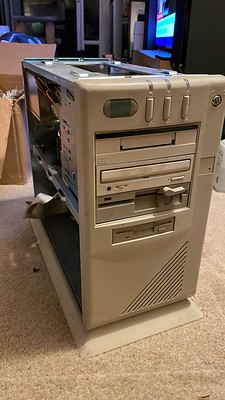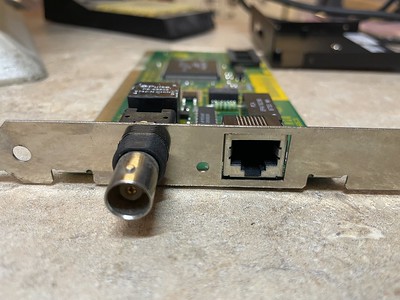[photos: flickr – 486 of Theseus]
I originally bought this 486DX2-66 system on eBay because I needed a legacy system with a floppy disk controller to run a Colorado tape drive, which it coincidentally had one, and Windows 95. The motherboard has VESA local bus slots on it too, something I wanted if I wound up getting a 486. VLB motherboards are running a couple hundred dollars on eBay because they’re getting hard to find, so I figured might as well buy the loaded system and get drives and other stuff as a bonus. Beyond getting the tape drive running, I decided to actually use the system for running old DOS games and whatnot. I might wind up moving my BBS over to it.
Except it turns out that most of the components were just old enough to be annoying and not support anything fun.
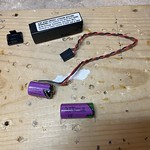 CMOS battery: fortunately the motherboard did not have a nicad battery on the motherboard (or somebody removed it), which is a major cause of corrosion and damage on old motherboards. It did have an external li-ion battery which was dead, so this was the first thing to replace.
CMOS battery: fortunately the motherboard did not have a nicad battery on the motherboard (or somebody removed it), which is a major cause of corrosion and damage on old motherboards. It did have an external li-ion battery which was dead, so this was the first thing to replace.
Bad SIMM: the system came with 32 MB of RAM in the form of 30-pin SIMMs, but one module was flaky which caused HIMEM.SYS to freak out and not load. Found a local memory vendor who specialized in legacy memory and got a new set of SIMMs.
PSU fan: the original fan was quite loud, so I replaced it with a Noctua fan. The CPU fan was also just dangling by its wire so I got some thermal tape and stuck it back on the CPU, it kinda stays there.
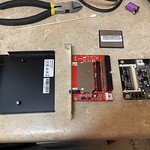 Hard drive: I straight up replaced the 480 MB Western Digital IDE drive with a compact flash reader to make it easier to move files back and forth from my modern systems and not depend on some 30 year old disk. Unfortunately I don’t think the CF reader I bought supports DMA or some sort of IDE block operation, read/write throughput feels lower than I remember, and a benchmark says it’s pretty slow.
Hard drive: I straight up replaced the 480 MB Western Digital IDE drive with a compact flash reader to make it easier to move files back and forth from my modern systems and not depend on some 30 year old disk. Unfortunately I don’t think the CF reader I bought supports DMA or some sort of IDE block operation, read/write throughput feels lower than I remember, and a benchmark says it’s pretty slow.
No LBA support in BIOS: the motherboard and BIOS came out riiiight before logical block addressing came about so it didn’t support any hard drive larger than ~504-518 MB. I could put in a 2 GB CF card and even enter it in as a 1918 MB type 47 drive in BIOS, but MS-DOS would only see it as a 500 MB drive. By the time I got Windows 95 installed and a couple of apps I was up to 350 MB used.
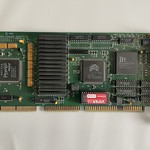 Janky VLB slots: first time I powered it up, it kept displaying the Diamond Viper BIOS over and over again. After temporarily swapping the card I realized it was either dirty or the VLB slots were dodgy. I could wiggle the video card and it would work, screw it down and it would not work. Finally after cleaning the card edge I think I fixed it and got that sucker screwed down.
Janky VLB slots: first time I powered it up, it kept displaying the Diamond Viper BIOS over and over again. After temporarily swapping the card I realized it was either dirty or the VLB slots were dodgy. I could wiggle the video card and it would work, screw it down and it would not work. Finally after cleaning the card edge I think I fixed it and got that sucker screwed down.
Janky VLB multi-I/O controller: this was working fine until one day I took it out to take pictures and clean it, I put it back in and it came up reporting the FDD and/or the HDD controller did not work. I could jiggle the card and then one or the other would work. Finally I replaced this with a Promise EIDE Pro controller which had its own LBA-enabled BIOS, so now I can use my 2 GB CF card and not have to worry about the card dropping off the bus.
CD-ROM: The one that came with it is a Sony or Mitsumi with its own 8-bit card. I need the slot so I eBay’d an ATAPI CD-R drive to replace it and use the secondary IDE channel on the Promise card.
EDIT: sigh, new ATAPI drive I bought doesn’t work. I verified the Promise controller does indeed support ATAPI, but it does not recognize the CD drive regardless if it’s master or slave on either primary or secondary IDE channels.
No high-speed serial ports: I discovered this while looking up part numbers on components as well as testing a modem. Further, for some odd reason the serial and parallel ports on the VLB multi-I/O card were disabled and there was a separate 8-bit multi-I/O card eating an extra slot. Originally I bought a new serial card with 16550 UARTs to use until I realized how unreliable the VLB I/O controller was. Fortunately the Promise EIDE Pro has high speed serial ports so that fixes that and frees up another slot.
All in all, I should’ve just watched for a decent 486DX2 motherboard for sale and built my own system instead of retrofitting this one.
I added a 3com 3c509 card which gives me both 10BaseT and 10Base2 (oh yes I’m gonna run coax) and a SoundBlaster AWE64 (hello Winamp!). The latter is overkill but was cheaper and smaller than the basic SB 16 cards. So now the config looks something like this:
- Aquarius Systems motherboard, Intel 486DX2-66 CPU
- 32 MB of 30-pin, 60ns SIMM memory
- TEAC 5.25″ 1.2 MB and 3.5″ 1.44 MB floppy drives
- Colorado 120/250 MB tape drive
- Sony 52X IDE CD burner
- StarTech IDE to external CF reader
- Transcend 2 GB industrial CF card
- Diamond Viper VLB graphics card with 2 MB VRAM
- Promise EIDE Pro multi-I/O controller (2x EIDE channels, high-speed floppy, 2 S/1 P/1 G, BIOS)
- 3com 3C509 combo network card
- SoundBlaster AWE64 sound card
